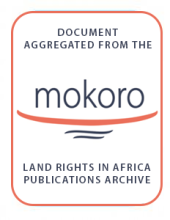Land Library
Welcome to the Land Portal Library. Explore our vast collection of open-access resources (over 74,000) including reports, journal articles, research papers, peer-reviewed publications, legal documents, videos and much more.
/ library resources
Showing items 1 through 9 of 10.Contains the common goal, delivery challenges, six stories and takeaways, frontiers for further investigation and innovation.
Since the global food crisis of 2008 the Tanzanian government has made food security through increases in agricultural productivity a policy priority. The emphasis is on commercialisation, with a particular focus on large-scale rice and sugarcane production.
A community land titling initiative designed to protect community lands from land grabbing. Supported communities in Liberia, Mozambique and Uganda to follow their countries’ community land registration laws. Sought to understand what type and level of support was most effective.
The first of 7 Working Papers presented at an FAO regional technical workshop for sub-Saharan Africa on legal empowerment of the poor (LEP) in Nakuru, Kenya, in October 2006.
Review of the situation of land rights in Apac District and of opportunities for land rights protection work. Examines the 1998 Land Act and its implementation in practice. Finds that the protection clauses for women are proving ineffective.
A comprehensive review covering stages in the development of Zambia’s land policy; land administration – customary land and leasehold tenure; land titling; current land policy consultation process; outstanding land policy issues – alienation of customary land, land market issues, problems faced b
Includes the need for tenure reform; the draft CLRB does not provide appropriate solutions; learning from the African and the South African experiences; why titling is generally inappropriate and ineffective; the unintended consequences of titling programmes; why the draft Bill will not be able t
Asks whether land reform is still a goal worth pursuing for rural women.
Examines evolution of land tenure reform in Kenya since Swynnerton Plan of 1954 with particular emphasis on the poverty impacts of titling. Concludes that land titling risks a negative impact on the poor.

